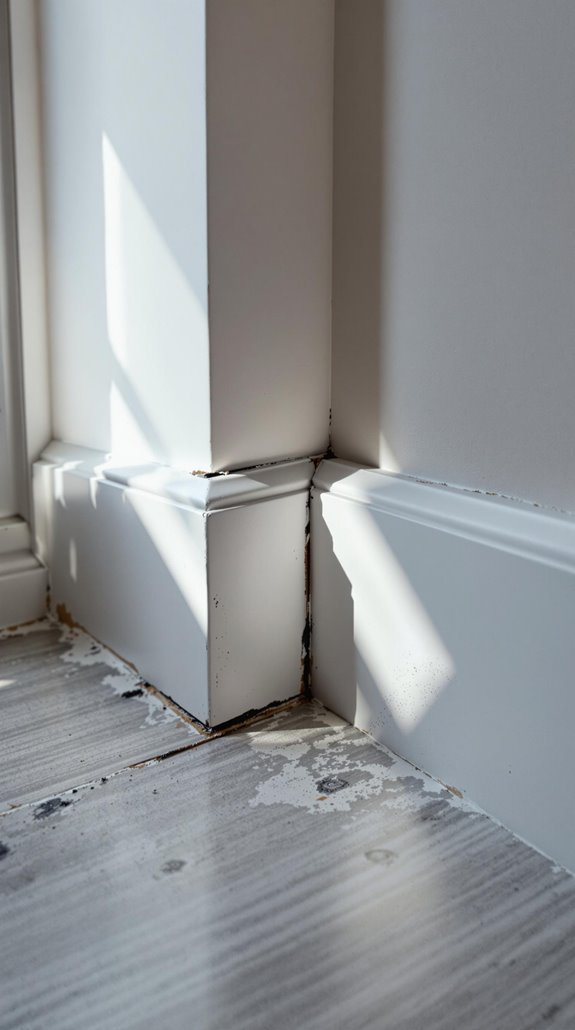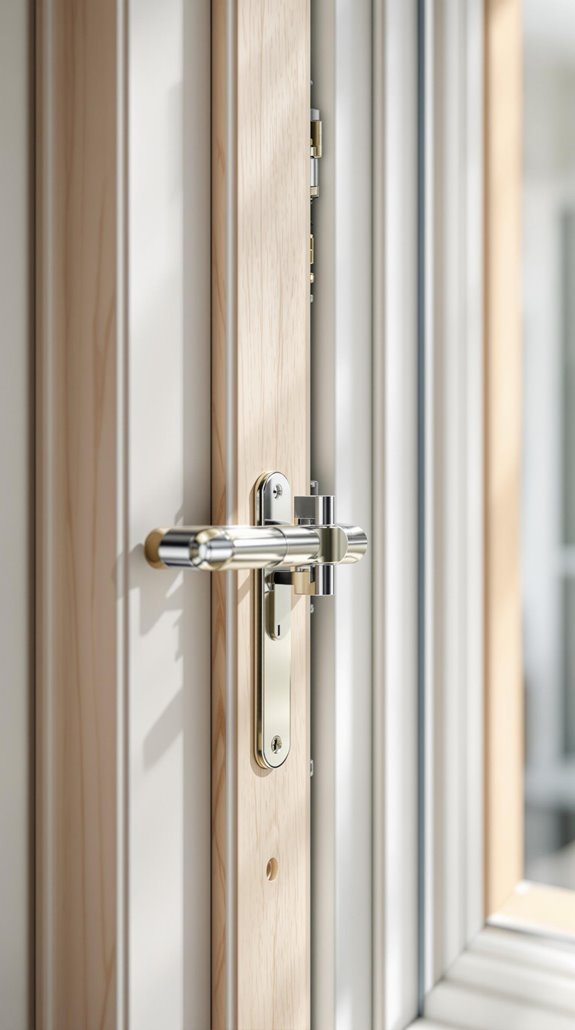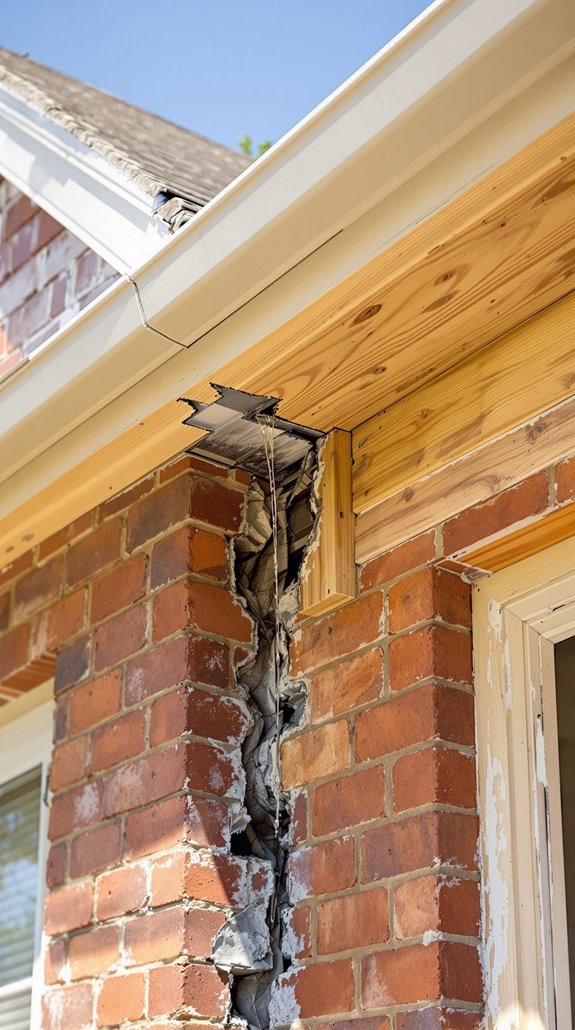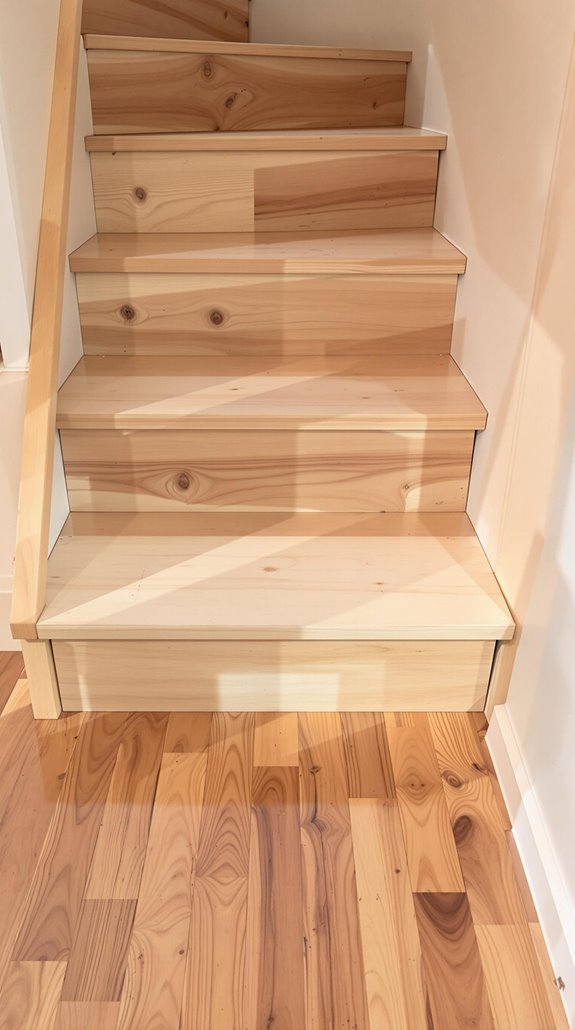I’ve seen countless new homeowners discover expensive defects months after moving in—problems that could’ve been caught during the snagging process. When you’re buying a new build, developers won’t tell you about the hairline cracks, wonky door frames, or faulty electrical outlets they’ve left behind. These aren’t just cosmetic issues; they’re potential safety hazards and financial drains. Let me show you exactly what to look for and how to protect yourself.
Key Takeaways
- Check for wall cracks over 2mm, foundation issues, and bowing walls as these indicate serious structural problems requiring immediate attention.
- Test all doors, windows, and locks for proper sealing and alignment to prevent drafts, security vulnerabilities, and energy inefficiency.
- Inspect plumbing thoroughly for leaks, mixed materials, and drainage issues that can cause costly sewage backups and water damage.
- Examine electrical systems for faulty wiring, circuit breaker trips, and missing fire blocking to prevent safety hazards and fires.
- Schedule snagging surveys during daylight hours and prioritize structural defects over cosmetic issues when documenting problems for developers.
What Is New Build Snagging and Why Does It Matter?

New build snagging transforms a potentially stressful property handover into a systematic quality control process. I’ll explain what you need to know about this critical step that protects your investment.
Snagging is a thorough audit identifying defects before you take ownership. It documents everything from paint flaws to misaligned fixtures, ensuring your property meets contractual specifications and building standards. This process validates construction quality against established benchmarks. Early detection of issues can prevent costly repairs related to structural integrity.
Why does it matter? Snagging prevents minor issues from becoming major structural problems. It’s mandatory for securing 10-year warranties and reduces post-occupancy repair costs by 20-30%. You’re not just getting a house inspection—you’re securing legal protection against substandard construction practices while maintaining your property’s value and energy efficiency. This quality assurance approach aligns with the New Homes Quality Code standards that enhance developer requirements and protect homebuyers.
Decorative and Finishing Problems That Reduce Property Value
While structural issues grab headlines, decorative and finishing problems silently erode your property’s value and create ongoing headaches. I’ve seen countless homeowners discover these issues after moving in, when fixes become your responsibility.
Wall cracks over 2mm indicate potential structural concerns, while poor plastering creates uneven surfaces and paint flaking. Crown molding separating from walls signals shoddy workmanship. Proper insulation can mitigate some of these issues, as it helps maintain (thermal efficiency) within the home.
Flooring problems include moisture-related adhesive failure and gaps between drywall and floor preventing proper wall base installation. Uneven flooring creates tripping hazards. Since moisture issues account for 85% of flooring installation failures, proper moisture testing should be completed before any flooring work begins.
Paint defects range from unfinished application to non-blended patches. Poorly fitted fixtures like dripping faucets and non-functioning lights require immediate attention.
External issues include concrete cracks over quarter-inch and poor pointing allowing water intrusion. These problems compound quickly if left unaddressed, and neglecting thermal efficiency can also contribute to increased energy costs.
Door and Window Issues That Compromise Security and Comfort

Beyond decorative flaws, door and window defects create serious security vulnerabilities and comfort issues that builders often overlook during final inspections. I’ve found that glass doors don’t actually increase burglary risk, but they’ll make you feel exposed and uncomfortable in your own home.
Check for gaps around frames that let drafts through—these compromise energy efficiency and comfort. Testing for drafts is crucial as it directly relates to energy efficiency standards that all homes should meet. Test every lock mechanism; builders often install cheap hardware that fails within months. Look for windows that don’t seal properly or doors that stick or swing open unexpectedly.
I always examine weather stripping for proper installation and coverage. Misaligned frames create ongoing problems you’ll deal with for years. Don’t let builders dismiss these issues as “settling”—proper installation prevents most problems entirely. Many security professionals have low confidence in standard glass protection against forced entry, rating it just 2.5 out of 5.
Plumbing and Water Management Defects to Watch For
Hidden beneath finished surfaces, plumbing defects cause the most expensive and disruptive problems in new construction. I’ve seen tree roots infiltrate new pipes, creating foul odors and sewage backups that’ll cost you thousands. Watch for mineral buildup in your water heater—it reduces efficiency and signals poor installation practices. A thorough drainage survey can reveal these hidden issues before they escalate.
Check your drainage immediately. Construction debris like drywall residue often clogs drains before you’ve even moved in. Listen for gurgling sounds—they indicate inadequate vent piping that violates building codes. Test water pressure throughout your home; undersized supply lines are common shortcuts builders take.
Don’t ignore mixed materials like copper connected to galvanized steel—this accelerates corrosion. Over-tightened fittings crack pipes within walls, creating hidden leaks you won’t discover until significant damage occurs. Pay attention to any dripping faucets, as these leaky faucets are often overlooked during construction but can escalate into significant issues.
Structural and Exterior Problems That Need Immediate Attention

Water damage from plumbing failures often leads to the most serious threat your new home faces—structural compromise. I’ve seen foundation cracks, bowing walls, and uneven floors destroy property values overnight. You’ll notice sticking doors and windows first—these signal frame misalignment from settlement.
Check your exterior cladding carefully. EIFS cracks let water penetrate walls, creating hidden rot you won’t discover until it’s expensive. Plugged weep holes trap moisture inside, while rusting nails compromise siding integrity. Vinyl siding detaches during storms when contractors skip proper installation procedures. A properly installed Damp Proof Course is essential to prevent moisture issues that could exacerbate these problems.
Your roof demands immediate attention for loose shingles and improper drainage. Standing water near foundations accelerates erosion. Inside, incorrectly constructed trusses and overdriven fasteners reduce your home’s structural capacity. Missing fire blocking increases spread vulnerability.
Don’t ignore these warning signs—they’re your early detection system.
Electrical and Fixture Installation Faults
While structural issues threaten your home’s integrity, electrical faults can kill you. I’ve seen too many new builds with defective wiring connections and inadequate grounding that builders left unfinished. You’ll notice frequent circuit breaker trips, voltage sags when appliances start, and light switches that don’t work properly.
Here’s what’s really dangerous: electrical fires cause 51,000 incidents annually, with arcing faults igniting 28,000 fires yearly. Your builder might’ve skipped critical AFCIs and GFCIs to cut costs, used undersized wiring for modern appliances, or installed non-weatherproofed outlets in damp areas. Even new homes can face code violations when contractors use lower-quality materials or make installation errors. Be aware that early detection of damp can also prevent further complications with electrical systems in your home.
Check every outlet, switch, and circuit breaker. Test your smoke alarms. Don’t let shoddy electrical work become your family’s nightmare—these aren’t cosmetic issues you can fix later.
Floor and Stair Defects That Affect Daily Living

Every step you take in your new home reveals whether your builder cut corners on flooring and stair installation. I’ve seen moisture cause 85% of flooring failures, leading to warped wood, adhesive breakdown, and voided warranties. You’ll notice tile cracks from poor drainage or soil movement, while concrete shrinkage cracks allow water seepage that worsens over time. Proper budgeting is essential to address these issues before they escalate.
Check for uneven wood flooring from incorrect nailing or substandard materials. Separating LVP or hardwood indicates humidity problems or poor slab preparation. On stairs, uneven treads create tripping hazards and signal installation errors.
Look for gaps at deck connections and stair railings—these indicate water intrusion risks and safety concerns. Improper grading around your foundation affects both floors and stairs, causing settlement issues that compromise structural integrity. Remember that inadequate surface preparation significantly reduces flooring longevity and can lead to premature replacement costs.
How to Conduct Your Own Snagging Survey
Before you walk through your new home with rose-colored glasses, arm yourself with a systematic approach that’ll catch defects your builder hopes you’ll miss.
I recommend tailoring your snagging checklist to your property’s specific features and installations. Print it out and bring a camera for photographic evidence—you’ll need concrete proof later. Schedule your survey during daylight hours before completion when you’ve got ideal visibility and time for fixes. Investing in a snagging survey can provide you with essential protection against potential costly repairs down the line.
Bring an electrical socket tester to verify outlet functionality throughout the property. Review your property plans and specifications beforehand so you can guarantee compliance during inspection.
Start with exterior elements: roofing, walls, windows, and doors. Then move inside to assess plasterwork, ceilings, and interior finishes. Test all electrical systems, plumbing connections, and fixtures systematically. Always prioritize structural issues over cosmetic defects when documenting your findings.
Getting Developers to Fix Snagging Issues Before Settlement

How can you guarantee developers actually fix the snagging issues you’ve documented before you complete your purchase? I’ll show you the proven approach that gets results.
First, use their formal complaint process if issues remain unresolved. Developers must acknowledge complaints within 5 days and provide resolution steps within 10 working days. Document everything—dates, conversations, and timelines create your evidence trail.
Professional snagging reports with photos and regulatory citations strengthen your position greatly. They can’t dismiss thorough documentation that references building standards. Professional snagging companies now utilize advanced technology including drone inspections and thermal imaging to identify defects that might otherwise be missed. Understanding the house survey costs can also help you budget for any required inspections.
Create a priority list for negotiations. Developers may refuse unreasonable requests, but they’re legally obligated to fix warranty-standard breaches. Don’t attempt DIY fixes—you’ll void their responsibility.
Finally, demand a de-snagging report verifying all repairs before settlement. Your new build warranty backs this requirement.
Conclusion
I can’t stress enough how critical snagging is for your new build investment. You’ll save thousands by catching defects before settlement rather than dealing with them afterward. Don’t rush this process—methodically inspect every surface, fixture, and system I’ve outlined. Document everything with photos and create a thorough list for your developer. Remember, once you’ve taken ownership, fixing these issues becomes your responsibility and expense. Act now while you still have leverage.
References
- https://www.ipgl.uk/latest-updates/top-5-snagging-issues
- https://newhomequalitycontrol.co.uk/common-snags-in-90-of-new-build-homes/
- https://eauditor.app/2024/05/16/new-build-snagging-checklist/
- https://livelyprofessionalservices.co.uk/common-snagging-defects/
- https://tpdsolutions.ie/10-common-issues-to-check-on-your-snag-list-before-moving-in/
- https://propertyinspect.com/uk/blog/what-is-a-snagging-list-inspection-template/
- https://blog.brightergraphics.com/what-is-snagging-in-construction
- https://consumercode.co.uk/snagging-what-is-it-and-how-does-it-help-you/
- https://www.sablono.com/en/blog/snagging-in-construction
- https://www.letsbuild.com/blog/snagging-in-construction

